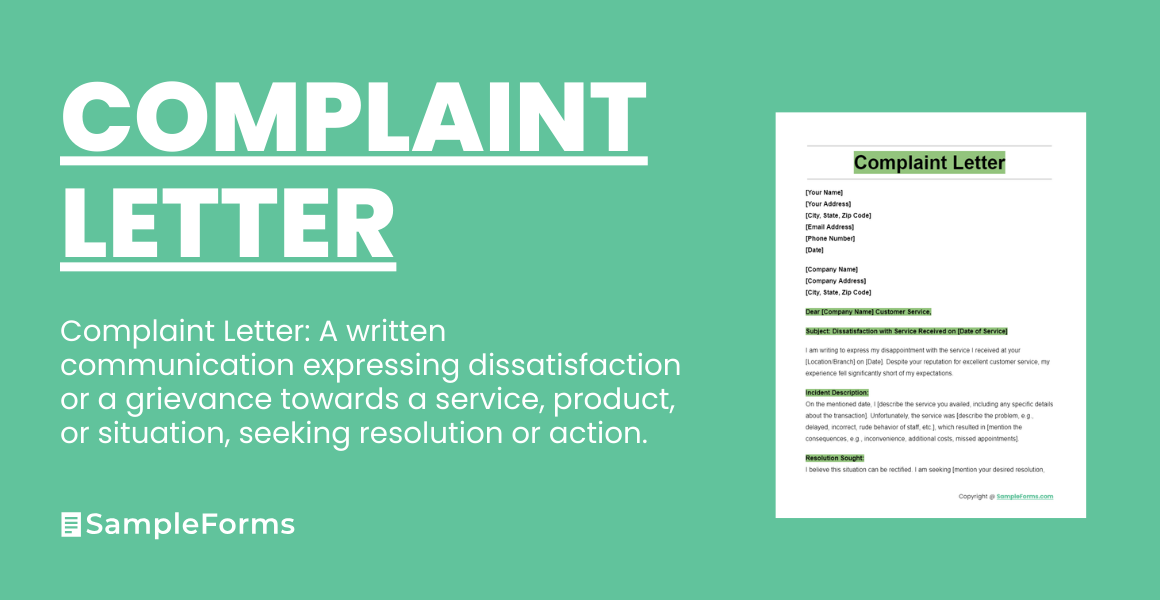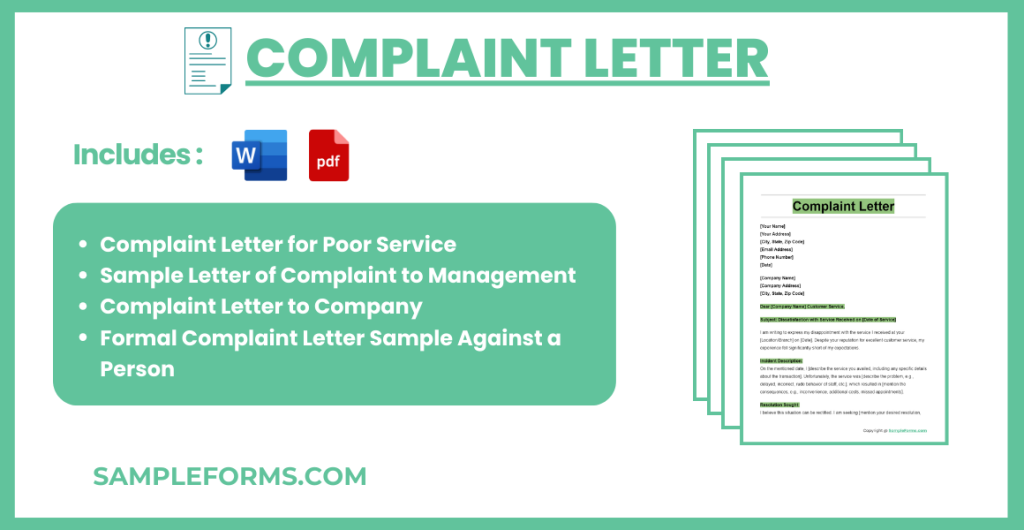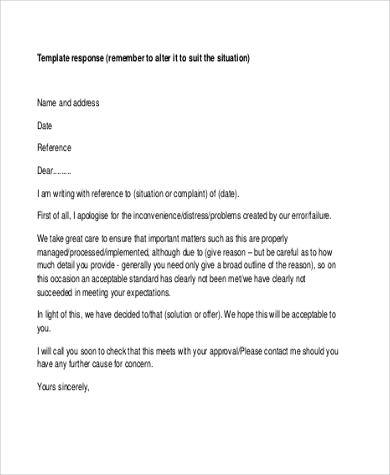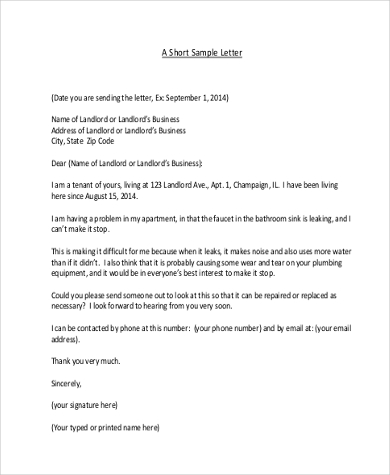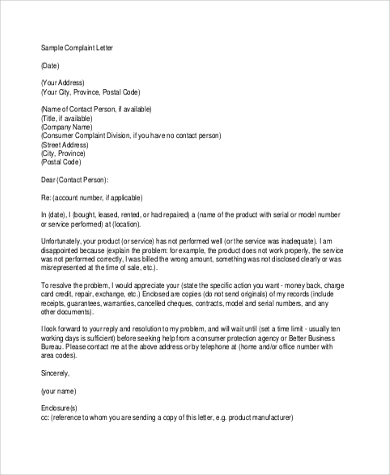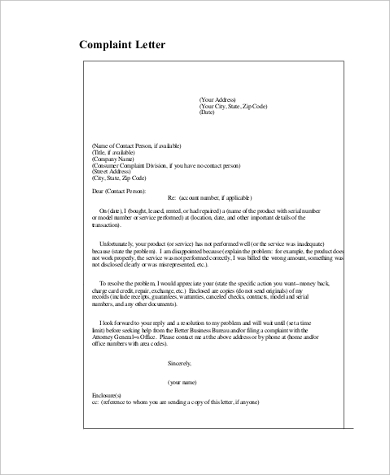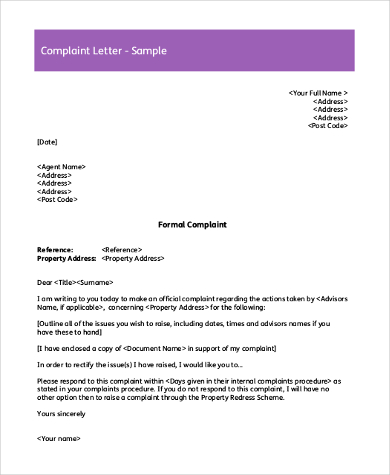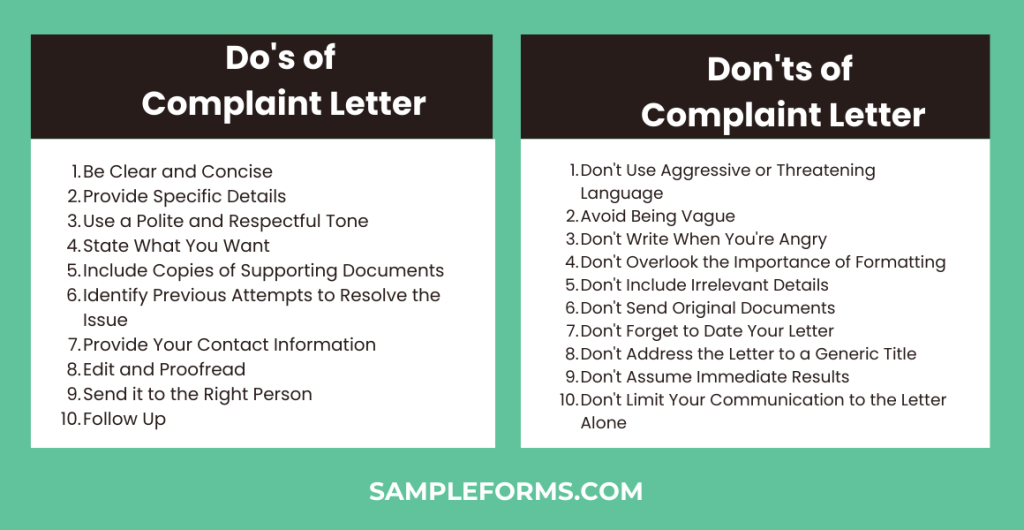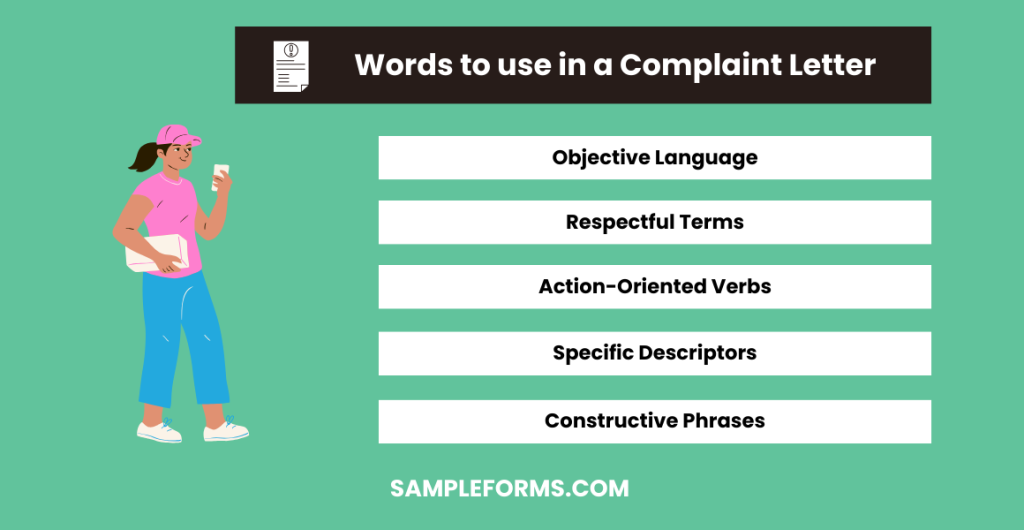Navigating the complexities of drafting a complaint letter can often feel daunting. Our complete guide demystifies this process, providing you with a wealth of examples and easy-to-follow advice. From structuring your letter to ensuring your voice is heard, we cover everything you need to write impactful complaint letters or Complaint Form. Dive into our resources, including Sample Letter, to learn how to articulate your grievances effectively and achieve the resolution you desire. Master the craft of complaint letter writing with our expert tips and make your concerns impossible to ignore.
Download Complaint Letter bundle
What is a Complaint Letter?
A complaint letter is a formal or semi-formal document written to an organization or individual, expressing dissatisfaction or a grievance over products, services, or situations. It serves as a means to raise concerns and seek resolution, providing a detailed account of the issue, its impact, and a desired outcome. The key to an effective complaint letter lies in its ability to communicate issues constructively, urging the recipient to understand and address the problem.
Complaint Letter Format
-
Header:
Include your contact information and the date.
-
Recipient Information:
Add the recipient’s name, title, and address.
-
Salutation:
Use a formal greeting.
-
Subject Line:
Clearly state the purpose of the letter.
-
Introduction:
Briefly introduce yourself and the purpose of your complaint.
-
Body:
- Incident Description:Detail the incident or issue.
- Impact: Describe how the issue has affected you.
- Resolution Sought: Specify the outcome you desire.
-
Conclusion:
Summarize your letter and express anticipation for a resolution.
-
Closing:
Politely close the letter with your name and signature.
-
Enclosures:
List any documents you’re including with your letter.
Complaint Letter for Poor Service
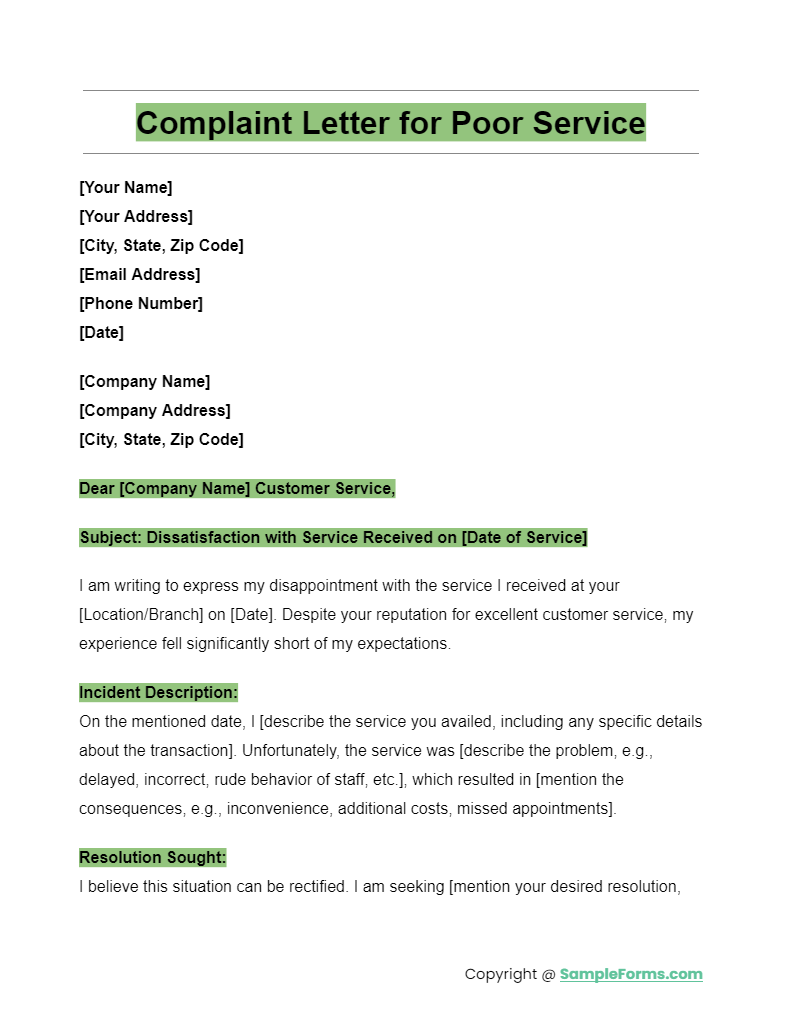
Craft a compelling Complaint Letter for Poor Service to address unsatisfactory experiences. Use a Formal Letter structure to outline issues and seek resolution, improving future service quality with a clear, respectful appeal. You should also take a look at our Harassment Complaint Form.
Sample Letter of Complaint to Management
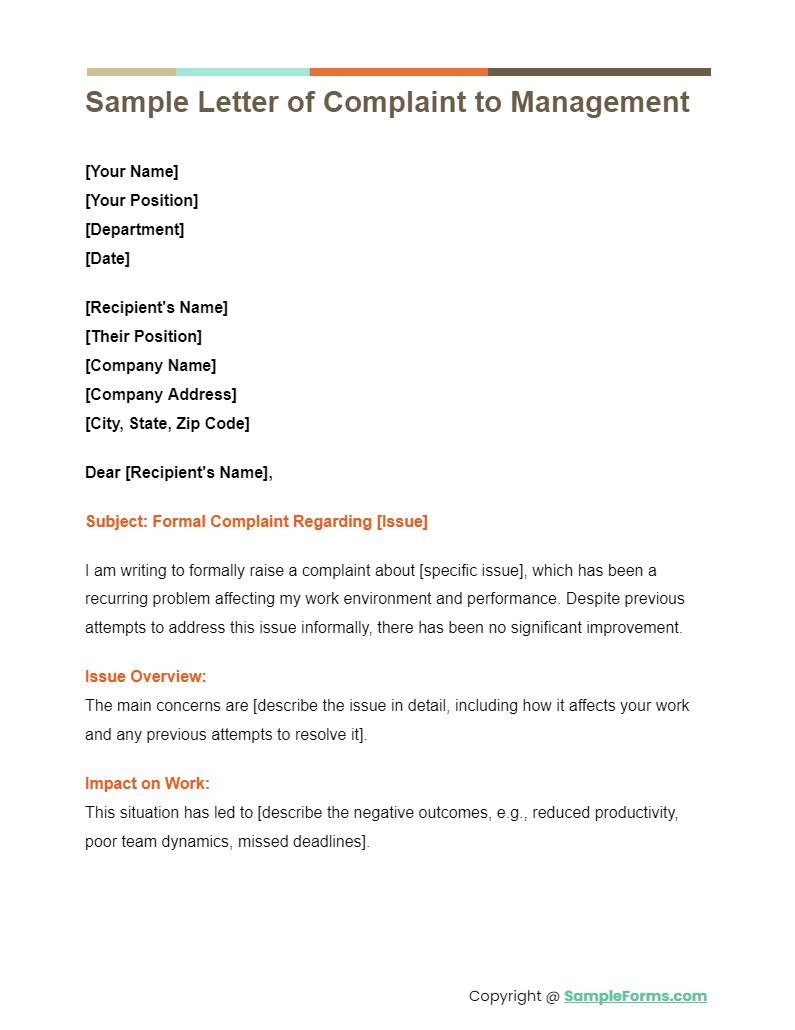
Our guide provides a Sample Letter of Complaint to Management, integrating an Appeal Letter Format. It’s designed to express concerns professionally, urging management to take actionable steps towards improvement and accountability. You should also take a look at our Criminal Complaint Form.
Complaint Letter to Company

Learn how to draft an impactful Complaint Letter to Company, mentioning specific incidents and expectations. Incorporating the Two Week Notice Letter principle, it encourages prompt responses and solutions to service or product issues. You should also take a look at our HR Complaint Form.
Formal Complaint Letter Sample Against a Person
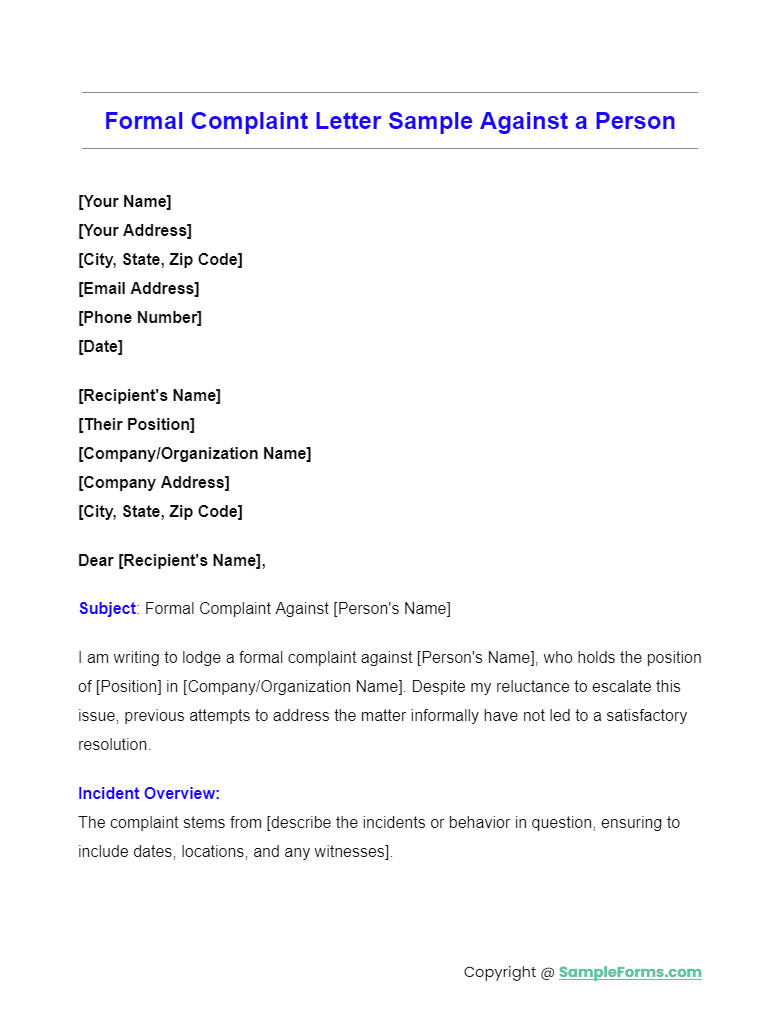
More Complaint Letter Samples
Sample Formal Complaint Letter
Response to Complaint Letter in PDF
Customer Complaint Letter Example
Complaint Letter to Landlord
Complaint Business Letter
Sample Complaint Food Letter
Product Complaint Letter
Complaint Letter Example
Complaint Letter Format
Do’s and Don’ts of a Complaint Letter
Writing an effective complaint letter requires a careful balance of assertiveness and professionalism. Here’s a guide to help you craft a letter that effectively communicates your concerns without crossing the line of respect and professionalism.
Do’s
- Be Clear and Concise: Clearly state the purpose of your letter from the beginning, focusing on the facts.
- Provide Specific Details: Include relevant dates, locations, and any other specific information that can substantiate your complaint.
- Use a Polite and Respectful Tone: Even if you’re frustrated, ensure your language remains respectful throughout the letter.
- State What You Want: Be clear about the resolution you’re seeking. Whether it’s a refund, replacement, or another solution, specify your desired outcome.
- Include Copies of Supporting Documents: Attach copies (not originals) of receipts, warranties, and other relevant documents.
- Identify Previous Attempts to Resolve the Issue: If you’ve already tried to fix the problem, mention these efforts and their outcomes.
- Provide Your Contact Information: Make it easy for the recipient to respond by including your full contact details.
- Edit and Proofread: Before sending, check for any spelling or grammar mistakes that could undermine your message.
- Send it to the Right Person: Address your letter to someone with the authority to resolve the complaint, such as a customer service manager.
- Follow Up: If you don’t receive a response within a reasonable timeframe, consider following up or exploring other avenues for resolution. You should also take a look at our Consumer Complaint Form.
Don’ts
- Don’t Use Aggressive or Threatening Language: This can escalate the situation and reduce your chances of a favorable outcome.
- Avoid Being Vague: Lack of detail can make your complaint seem unfounded or difficult to address.
- Don’t Write When You’re Angry: Wait until you’ve calmed down to ensure your tone is professional.
- Don’t Overlook the Importance of Formatting: A letter that’s difficult to read due to poor formatting won’t be taken as seriously.
- Don’t Include Irrelevant Details: Stick to information directly related to your complaint to keep the letter focused.
- Don’t Send Original Documents: Always send copies to avoid losing important documents.
- Don’t Forget to Date Your Letter: This provides a timeline that can be important for resolving your complaint.
- Don’t Address the Letter to a Generic Title: Find out who is responsible for handling complaints and address them directly.
- Don’t Assume Immediate Results: Some resolutions take time, so be patient while waiting for a response.
- Don’t Limit Your Communication to the Letter Alone: If necessary, be prepared to escalate your complaint to higher authorities or seek legal advice. You should also take a look at our Grievance Complaint Form.
Crafting your complaint letter with these do’s and don’ts in mind will increase your chances of achieving a satisfactory resolution. You should also take a look at our Student Complaint Form.
How do I Write a Complaint Letter?
Writing a complaint letter effectively requires a structured approach to convey your concerns clearly and professionally. Here’s how to do it in steps:
- Start with Your Contact Information: Like an Example Cover Letter, begin by providing your name, address, and contact details at the top of the letter.
- Include the Date and Recipient’s Details: Just below your contact information, add the date and the recipient’s name, title, and address.
- Open with a Formal Salutation: Use a formal greeting, such as “Dear [Recipient’s Name]”.
- State the Purpose of Your Letter: Clearly mention that you are writing to lodge a complaint.
- Describe the Issue: Concisely explain the problem, including relevant dates, locations, and other specifics. Incorporate elements akin to a credit report dispute letter if your complaint involves financial inaccuracies.
- Reference Any Previous Communications: If applicable, mention any prior attempts to resolve the issue.
- Express Your Desired Outcome: Clearly state what action you expect to be taken.
- Close with a Call to Action: Politely urge the recipient to address your concerns, mentioning any deadlines if necessary.
- Sign Off Formally: Conclude with a formal closing, such as “Sincerely,” followed by your signature and printed name. You should also take a look at our Maintenance Complaint Form.
What not to Write in a Complaint Letter?
To maintain professionalism and effectiveness in your complaint letter, avoid these elements:
- Personal Attacks and Emotional Language: Keep the tone respectful and focus on facts rather than emotions.
- Excessive Length: Be concise. Avoid overly lengthy explanations that could dilute the importance of your key points.
- Irrelevant Information: Do not include details unrelated to the specific issue at hand.
- Ultimatums or Threats: Avoid making threats or demands. Instead, request a reasonable solution.
- Poor Grammar and Spelling Mistakes: Like a polished Application Letter, ensure your complaint letter is well-written and free of errors. You should also take a look at our Noise Complaint Form.
How do you Politely Write a Complaint?
Writing a polite complaint involves a careful choice of words and a respectful tone:
- Choose a Professional Tone: Start with a positive statement or gratitude for the service/product before stating your complaint.
- Clearly State the Problem: Like a Formal Letter, use clear and concise language to describe the issue without blaming or anger.
- Provide Evidence: Attach any relevant documents or photos as evidence, akin to the meticulous detail in a Letter of Intent Format.
- Suggest a Solution: Politely suggest how you would like the issue to be resolved.
- Thank for their Time: Conclude by thanking the recipient for their attention to the matter. You should also take a look at our Product Complaint Form.
What Words to use in a Complaint Letter?
Choosing the right words is crucial for a constructive complaint letter:
- Objective Language: Use factual and objective language to describe the issue.
- Respectful Terms: Maintain respect with words like “please,” “thank you,” and “respectfully.”
- Action-Oriented Verbs: Use verbs that convey the action you expect, such as “resolve,” “address,” and “acknowledge.”
- Specific Descriptors: Be specific about dates, times, and descriptions of the issue.
- Constructive Phrases: Phrases like “I believe a possible solution could be…” or “I suggest…” are constructive and helpful. You should also take a look at our Tenant Complaint Form.
How do I Write a Complaint Letter for Unprofessional Behavior?
Addressing unprofessional behavior requires a tactful and direct approach:
- Begin with Formalities: Like any professional letter, start with your information, the date, and the recipient’s details.
- State Your Purpose: Indicate that you are writing to address instances of unprofessional behavior.
- Describe Specific Incidents: Provide details of specific incidents, including dates, locations, and how the behavior affected you or your work.
- Refer to Policies or Expectations: If applicable, reference company policies or professional standards that were not met.
- Request Action: Politely request that appropriate measures be taken to address the behavior.
- Include a Call to Action: Similar to a Job Recommendation Letter, Letter of Recommendation for Employment, or Personal Letter of Recommendation, your closing should encourage a positive step forward.
- Close Formally: End the letter with a respectful sign-off, thanking the recipient for their attention to the matter. You should also take a look at our School Complaint Form.
How do you Ask for Compensation in a Complaint Letter?
Specify the issue clearly, akin to a Termination Letter clarity, and politely state the compensation you seek. Reference receipts or agreements to strengthen your request.
What’s the Most Common Complaint?
The most common complaint often relates to poor customer service, reflecting a disconnect similar to issues addressed in a Two Weeks Notice Resignation Letter for unsatisfactory work conditions.
How long Should a Letter of Complaint be?
A Letter of Complaint should be concise and focused, ideally one page long, much like the brevity and directness of a 1 Week’s Notice Resignation Letter.
Would a Letter of Complaint be Formal?
Yes, a Letter of Complaint should maintain a formal tone, utilizing a structured approach similar to a Recommendation Letter Format, ensuring respect and professionalism throughout.
How Should I End a Complaint Letter?
Conclude with a respectful call to action, thanking the recipient for their attention, mirroring the appreciative closure of a Legal Confirmation Letter.
Related Posts
-
Security Deposit Return Letter
-
FREE 5+ Fraternity Recommendation Letters in PDF
-
Audit Response Letter
-
Medical School Recommendation Letter
-
Law School Recommendation Letter
-
FREE 9+ Paralegal Recommendation Letters in PDF | MS Word
-
FREE 9+ Professional Recommendation Letters in PDF | MS Word
-
FREE 5+ Employment Resignation Letters in PDF
-
Official Resignation Letter
-
Character Reference Letter for Immigration
-
Job Recommendation Letter
-
Tenant Recommendation Letter
